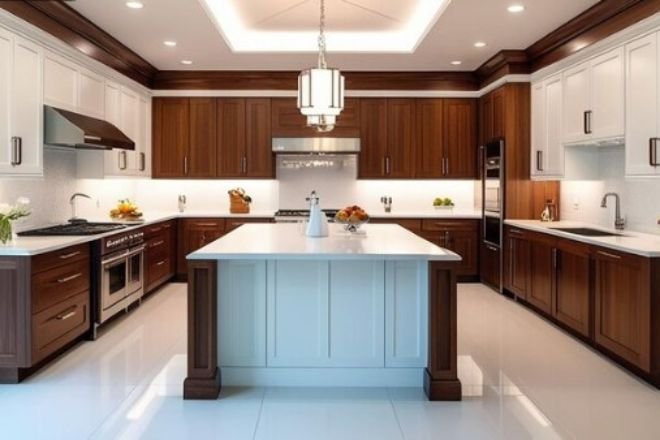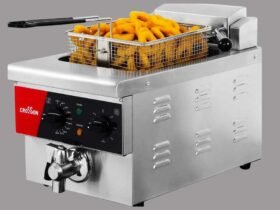Table of Contents: Kitchen Remodel on a Budget
Renovating your kitchen doesn’t need to break the bank. Start by identifying the most critical areas that require attention. Small changes, such as a fresh coat of paint or new cabinet hardware, can significantly impact. Opt for energy-efficient lighting to reduce long-term costs.

Kitchen Remodel on a Budget
DIY projects can further save money, giving your kitchen a personal touch. Consider repurposing existing materials or shopping for second-hand items to cut expenses. With strategic planning and creativity, you can achieve a stunning kitchen remodel without overspending.
Assessing Your Needs
Renovating a kitchen can be costly. But with careful planning, a budget-friendly kitchen renovation is possible. This guide will help you learn how to remodel a kitchen on a budget by assessing your needs. By determining your goals and identifying must-haves vs. nice-to-haves, you can create a beautiful kitchen without breaking the bank.
Determining Your Goals
Before starting your affordable kitchen makeover, it’s crucial to determine your goals. Ask yourself what you want to achieve with this renovation.
- Do you need more storage space?
- Are you looking to update the look and feel?
- Is functionality a major concern?
Setting clear goals helps you focus on what’s important. This will help you avoid unnecessary expenses. Here are some examples of goals for a DIY kitchen remodel on a budget:
| Goal | Examples |
| Improving Storage | Add more cabinets, install shelves |
| Updating Style | Paint walls, change cabinet doors |
| Enhancing Functionality | Reorganize layout, update appliances |
Having these goals in mind will guide your decision-making process. It ensures that every change you make is purposeful and within your budget.
Identifying Must-haves Vs. Nice-to-haves
Identifying must-haves vs. nice-to-haves is key to a cheap Kitchen Remodel on a Budget. Must-haves are essential items you cannot live without. Nice-to-haves are things that are good to have but not essential.
Start by listing all the features you want in your kitchen. Next, categorize them into must-haves and nice-to-haves.
| Must-Haves | Nice-to-Haves |
| Working sink | Fancy backsplash |
| Functional stove | High-end countertops |
| Basic storage | Decorative lighting |
This way, you can focus your budget on the essentials. If there’s leftover money, then you can add some nice-to-haves.
For example, prioritize fixing a broken sink over installing an expensive backsplash. This approach ensures a functional and beautiful kitchen without overspending. By following these low-cost kitchen remodelling tips, you can achieve a stunning kitchen on a budget.
Setting A Realistic Budget
Remodelling a kitchen can be expensive. But with careful planning, it’s possible to do it on a budget. Setting a realistic budget is crucial. This helps to avoid overspending and ensures you get the best value for your money.

Kitchen Remodel on a Budget
Researching Cost Factors
Before starting a kitchen remodel, it’s important to research cost factors. Knowing what influences costs helps in making informed decisions.
Here are some key cost factors:
- Materials: The type of materials used can significantly affect the cost. For example, granite countertops are more expensive than laminate ones.
- Labour: Hiring professionals for tasks like plumbing and electrical work can add to the cost.
- Appliances: High-end appliances cost more than standard ones. Consider energy-efficient models to save on utility bills in the long run.
- Permits: Some remodeling projects require permits. Check local regulations to find out if this applies to your project.
- Unexpected Costs: Always set aside a portion of the budget for unexpected expenses. This could include issues like water damage or outdated wiring.
Comparing prices from different suppliers can also help save money. Look for sales or discounts on materials and appliances. This can make a big difference in the overall cost.
Determining Cost Allocation
Determining cost allocation is the next step. This means deciding how much of the budget to spend on each part of the remodel.
Here’s a simple way to allocate your budget:
| Category | Percentage of Budget |
| Cabinets | 30% |
| Countertops | 10% |
| Appliances | 20% |
| Labor | 25% |
| Flooring | 10% |
| Other | 5% |
For example, if you have a budget of $10,000, you would spend $3,000 on cabinets and $2,500 on labour. This helps to keep spending in check and ensures all aspects of the remodel are covered.
Always review and adjust the budget as needed. If one area costs more than expected, find ways to save in another area. This approach keeps the project on track and within budget.
Diy Vs. Hiring Professionals
Remodelling a kitchen can be expensive. But, there are ways to do it without breaking the bank. Deciding between a DIY approach or hiring professionals is crucial. This decision impacts the cost and the overall experience. Let’s explore the pros and cons of each option. We’ll also discuss evaluating your skills and getting multiple quotes.
Evaluating Your Skills And Time

Kitchen Remodel on a Budget
Thinking about a DIY kitchen remodel on a budget? Start by evaluating your skills and time. Some tasks are easy and fun. Others might be complex and time-consuming. Here are some points to consider:
- Skill Level: Can you paint, install cabinets, or lay tiles?
- Time: Do you have enough free time for the project?
- Tools: Do you own the necessary tools? If not, can you rent or borrow them?
- Safety: Are you comfortable handling electrical or plumbing work?
List your strengths and weaknesses. This helps you understand what you can do on your own. For example, painting is often an easy task. But, installing new countertops might need professional help. Knowing your limits can save you money and prevent mistakes.
Here’s a simple table to help you decide:
| Task | Can Do Myself | Need Professional |
| Painting | Yes | No |
| Cabinet Installation | Maybe | Maybe |
| Electrical Work | No | Yes |
By evaluating your skills and time, you can decide on a budget-friendly kitchen renovation. This approach helps you balance cost and effort.
Getting Multiple Quotes
Hiring professionals for a cheap kitchen remodel idea can be smart. But always get multiple quotes. This ensures you get the best price. Here’s how to do it:
- Research: Look for reputable contractors in your area. Read reviews and check their past work.
- Ask for Quotes: Contact at least three contractors. Provide them with the same project details.
- Compare: Look at the quotes carefully. Compare prices, materials, and timelines.
- Negotiate: Don’t be afraid to negotiate. Ask if they can match or beat competitors’ prices.
Here’s a sample table to help you compare quotes:
| Contractor | Price | Materials Included | Timeline |
| Contractor A | $5,000 | Yes | 4 weeks |
| Contractor B | $4,500 | No | 5 weeks |
| Contractor C | $5,200 | Yes | 3 weeks |
Getting multiple quotes helps you make an informed decision. This ensures an affordable kitchen makeover without sacrificing quality. Always ask questions and understand what you’re paying for. This approach leads to a successful low-cost Kitchen Remodel on a Budget project.
Maximizing Cost-efficient Updates
Updating your kitchen doesn’t have to be expensive. Smart choices can lead to a beautiful and functional space. Focusing on cost-efficient updates can stretch your budget further. This guide will help you navigate the world of kitchen remodelling without emptying your wallet.
Refurbishing Vs. Replacing
Choosing between refurbishing and replacing can impact your budget. Refurbishing often costs less and can be just as effective. Consider these options:
- Inexpensive kitchen cabinets: Instead of replacing, try painting or refacing. Adding new handles can also give a fresh look.
- Budget countertop options: Laminate and butcher block are cheaper alternatives to granite or quartz.
- Affordable kitchen appliances: Look for sales or gently used items. These can save you a lot of money.
Here’s a table to compare the costs:
| Item | Refurbishing Cost | Replacing Cost |
| Cabinets | $200 – $1,000 | $4,000 – $10,000 |
| Countertops | $300 – $800 | $2,000 – $5,000 |
| Appliances | $150 – $500 | $1,000 – $5,000 |
Refurbishing can save you money and still give your kitchen a fresh look. Always consider your Kitchen Remodel on a Budget cost per square foot to stay within budget.
Incorporating Energy-efficient Fixtures
Energy-efficient fixtures can save you money in the long run. They reduce utility bills and are better for the environment. Here are some tips:
- LED lighting: These bulbs use less energy and last longer than traditional ones.
- Energy Star appliances: Look for the Energy Star label. These appliances use less water and electricity.
- Low-flow faucets: These fixtures reduce water usage without sacrificing performance.
Investing in energy-efficient options can seem costly upfront. But the savings on bills make it worth it. Here’s a comparison:
| Fixture | Cost | Annual Savings |
| LED Bulbs | $2 – $8 each | $50 – $100 |
| Energy Star Fridge | $500 – $2,000 | $100 – $150 |
| Low-Flow Faucet | $20 – $100 | $20 – $40 |
Energy-efficient upgrades are a smart choice for any budget. They help you save money and reduce your kitchen’s impact on the planet.
Strategic Design Choices
Remodeling your kitchen can be exciting but costly. With strategic design choices, you can create a beautiful space without breaking the bank. This guide will help you make smart decisions that save money while achieving a stylish kitchen.
Optimizing Layout For Cost Savings
Optimizing your kitchen layout can save you a lot of money. Keep the existing plumbing where it is. Moving sinks and dishwashers adds to the cost. Use the work triangle rule. The sink, stove, and fridge should form a triangle. This layout is both efficient and cost-effective.
Consider these layout tips:
- Open shelving instead of closed cabinets saves money and looks trendy.
- Repaint existing cabinets instead of buying new ones.
- Install a kitchen island if space allows. It adds storage and prep space.
Take a look at this cost comparison:
| Item | Cost |
| New Cabinets | $5,000 – $10,000 |
| Repainting Cabinets | $200 – $600 |
| Open Shelving | $50 – $200 |
Selecting Affordable Materials
Choosing the right materials can drastically lower your costs. Laminate countertops are cheaper than granite or marble. They come in various colors and patterns. Vinyl flooring is another budget-friendly option. It mimics the look of wood or tile without the high price.
Here are some affordable material options:
- Butcher block countertops are warm and affordable.
- Ceramic tiles for backsplashes are cost-effective and stylish.
- Stock cabinets from big-box stores are less expensive than custom ones.
See this comparison of different materials:
| Material | Cost per Square Foot |
| Granite Countertops | $50 – $100 |
| Laminate Countertops | $10 – $40 |
| Vinyl Flooring | $2 – $5 |
| Ceramic Tiles | $1 – $5 |
Sourcing Affordable Materials
Remodelling a kitchen can be costly, but it doesn’t have to be. By sourcing affordable materials, you can transform your kitchen without breaking the bank. This guide will help you find inexpensive kitchen cabinets, budget countertop options, and affordable kitchen appliances. Let’s explore how to keep your Kitchen Remodel on a Budget cost per square foot low.
Exploring Secondhand Options
Secondhand stores are great places to find affordable materials for your kitchen remodel. Many people donate items they no longer need. This can include everything from inexpensive kitchen cabinets to budget countertop options. Here are some tips to get you started:
- Visit Habitat for Humanity ReStores: These stores sell new and gently used furniture, appliances, and building materials. The prices are much lower than retail.
- Check online marketplaces: Websites like Craigslist, Facebook Marketplace, and eBay often have affordable kitchen appliances and fixtures.
- Join local buy/sell groups: Many communities have online groups where people sell or give away items they no longer need.
Purchasing secondhand can significantly reduce your kitchen remodel cost per square foot. Often, you can find items that are in excellent condition for a fraction of the price. Here’s a quick comparison:
| Item | Retail Price | Secondhand Price |
| Kitchen Cabinets | $2,000 | $800 |
| Countertops | $1,500 | $600 |
| Appliances | $3,000 | $1,200 |
Utilizing Discount And Clearance Sales
Discount and clearance sales offer great opportunities to purchase materials at reduced prices. Many stores have annual sales or clearance events where you can find affordable kitchen appliances and other items. Follow these tips to make the most of these sales:
- Sign up for store newsletters: Many stores send out emails about upcoming sales and special promotions.
- Shop during holiday sales: Events like Black Friday, Memorial Day, and Labor Day often have significant discounts.
- Check the clearance sections: Many stores have sections dedicated to discounted items. These can include budget countertop options and inexpensive kitchen cabinets.
Planning and keeping an eye on sales can drastically reduce your Kitchen Remodel on a Budget cost per square foot. Here’s an example of potential savings:
| Item | Regular Price | Sale Price |
| Kitchen Cabinets | $2,000 | $1,200 |
| Countertops | $1,500 | $900 |
| Appliances | $3,000 | $1,800 |
With these strategies, you can achieve your dream kitchen without spending a fortune.
Project Management And Timeline

Kitchen Remodel on a Budget
Remodelling a kitchen can be exciting but also challenging. Staying within budget requires careful planning and smart decisions. Project management and timeline are key to a successful remodel. Proper scheduling ensures everything runs smoothly and keeps costs down. Let’s explore how to manage a Kitchen Remodel on a Budget effectively.
Creating A Detailed Schedule
A detailed schedule is crucial for a kitchen remodel. List all tasks and assign time frames to each. This keeps everyone on track and avoids delays.
Here’s how to create an effective schedule:
- Plan the design phase: Choose your style and gather ideas from the best kitchen remodel blogs and Kitchen Remodel on a Budget inspiration sites.
- Set a timeline: Allocate time for demolition, plumbing, and electrical work.
- Order materials early: Ensure cabinets, countertops, and appliances are ordered in advance.
- Schedule contractors: Book professionals like electricians and plumbers ahead of time.
- Monitor progress: Regularly check if tasks are completed on time.
Creating a schedule helps identify potential delays early. Use tools like calendars or project management apps. This ensures a smooth workflow and a successful remodel.
Managing Unexpected Costs
Unexpected costs can arise during a remodel. Setting aside a contingency budget helps manage these surprises. Typically, allocate 10-20% of your total budget for unforeseen expenses.
Common unexpected costs include:
- Structural issues: Hidden problems like mould or faulty wiring.
- Material price changes: Sudden price hikes in essential materials.
- Design changes: Last-minute alterations to the original plan.
Here are tips to manage unexpected costs:
- Get multiple quotes: Compare prices from different contractors.
- Track expenses: Keep an eye on your spending throughout the project.
- Prioritize tasks: Focus on essential tasks first, and delay non-essential ones if needed.
Staying flexible and prepared helps handle surprises. Kitchen remodels before and after stories often show the benefits of careful planning. For more tips, explore Kitchen Remodel on a Budget and look at kitchen remodel pictures for ideas.
Prioritizing Essential Upgrades
Remodeling your kitchen on a budget can be exciting and challenging. Prioritizing essential upgrades can help you make the most of your money. This blog post will guide you through focusing on functional improvements and balancing aesthetics with necessities.
Focusing On Functional Improvements
Functional improvements ensure your kitchen works efficiently. Consider upgrading these key areas:
- Cabinetry: Replace old cabinets with new, budget-friendly options.
- Lighting: Install energy-efficient LED lights to brighten the space.
- Plumbing: Fix leaks and replace old faucets with water-saving models.
Another important area is storage. Good storage solutions can make your kitchen more organized. Use pull-out shelves and drawer organizers. These can be cost-effective and improve functionality.
Updating appliances can also make a big difference. Choose energy-efficient models to save on utility bills. Look for deals and discounts to stay within your budget.
Here is a simple table to summarize some functional upgrades:
| Upgrade | Benefit |
| Cabinetry | Better storage and modern look |
| Lighting | Improved visibility and energy savings |
| Plumbing | Reduced water wastage |
| Appliances | Lower utility bills |
Balancing Aesthetics With Necessities
Balancing aesthetics with necessities is crucial in a budget kitchen remodel. Start with a clear vision of what you want. Think about the colour scheme and style that fits your home.
Choose materials that look good but are affordable. For example, laminate countertops can mimic the look of stone at a fraction of the cost. Use peel-and-stick backsplash tiles for a stylish yet budget-friendly update.
Here are some tips to balance aesthetics and necessities:
- Paint: A fresh coat of paint can transform your kitchen.
- Hardware: Update handles and knobs for a new look.
- Flooring: Consider vinyl or laminate flooring options.
Keep an eye on sales and discounts for stylish items. Thrift stores and online marketplaces can offer great deals. Remember, small changes can have a big impact without breaking the bank.
Here is a table to summarize balancing aesthetics with necessities:
| Element | Affordable Option |
| Countertops | Laminate |
| Backsplash | Peel-and-stick tiles |
| Paint | Budget-friendly paint |
| Flooring | Vinyl or laminate |
Incorporating Cost-saving Techniques
Remodeling your kitchen doesn’t need to break the bank. Cost-saving techniques can help you create a beautiful space without spending too much. From repurposing existing features to optimizing your space, there are many ways to save. This guide will show you how to achieve a stunning kitchen remodel on a budget.
Repurposing Existing Features
Repurposing existing features is a great way to save money. Instead of buying new items, think about how you can reuse what you already have. For example, refinishing your cabinets can give them a fresh look. A new coat of paint can make old cabinets look brand new.
Here are some cost-saving ideas for repurposing:
- Refinish or paint cabinets instead of replacing them.
- Update hardware like handles and knobs for a fresh look.
- Repurpose old furniture like tables or chairs with a new finish or paint.
Look at the best kitchen remodel blogs and kitchen remodel before and after pictures for inspiration. You can find many ideas that show how to reuse existing features in creative ways. Kitchen Remodel on a Budget often have tips on how to repurpose items effectively.
Implementing Space-optimizing Solutions
Optimizing space is key to making your kitchen more functional. You don’t need to expand your kitchen to make it work better. Simple changes can make a big difference. Using space-saving solutions can help you create a more organized and efficient kitchen.
Here are some ideas to optimize space:
- Install pull-out shelves to make cabinets more accessible.
- Use vertical storage solutions like tall shelves or hanging racks.
- Add hooks for hanging pots, pans, and utensils.
Reviewing kitchen remodel pictures can give you ideas on how to use space better. Many Kitchen Remodel on a Budget inspiration articles feature smart storage solutions. These ideas can help you make the most of your space without spending a lot of money.
Maintaining Quality Within the Budget
Kitchen remodels can be daunting, especially when working with a tight budget. However, maintaining quality within budget is achievable with the right strategies. By understanding the true value of materials and focusing on long-term durability, you can create a beautiful and functional kitchen without overspending. This blog will provide insights and tips to help you make informed decisions for your kitchen remodel.
Understanding Value Vs. Cost
One key to a successful kitchen remodel on a budget is understanding the difference between value and cost. It’s easy to focus solely on the price tag, but it’s crucial to consider the overall value a purchase brings.
For instance, choosing high-quality materials that are slightly more expensive can save money in the long run. Here are a few points to consider:
- Durability: Materials that last longer reduce the need for replacements.
- Maintenance: Low-maintenance items save time and money on upkeep.
- Aesthetics: Quality materials often look better and add more value to your home.
Many of the best Kitchen Remodel on Budget blogs emphasize the importance of balancing cost with value. For example, opting for a mid-range countertop material that’s both durable and stylish can be more economical than choosing the cheapest option available.
Here’s a simple table to illustrate the concept:
| Material | Initial Cost | Longevity | Maintenance |
| Laminate Countertop | Low | 5-10 years | High |
| Quartz Countertop | Medium | 15-25 years | Low |
| Granite Countertop | High | 20+ years | Medium |
By considering these factors, you can make smarter choices that provide better value without breaking the bank.
Investing In Long-term Durability
Another important aspect of a budget kitchen remodel is investing in long-term durability. Prioritizing items that withstand the test of time can save significant money over the years.
For example, solid wood cabinets may have a higher upfront cost but offer exceptional durability. They often last for decades with proper care. This makes them a worthwhile investment compared to cheaper particleboard options that may need replacing sooner.
Here are a few tips to ensure long-term durability in your kitchen remodel:
- Choose quality over quantity: It’s better to have fewer high-quality items than many low-quality ones.
- Focus on high-traffic areas: Invest more in areas that see the most use, like countertops and flooring.
- Read reviews: Consult kitchen remodel websites and best kitchen remodel blogs for insights on the durability of different materials and products.
Many homeowners share their kitchen remodel before and after experiences online, providing valuable lessons on what works best. Looking at Kitchen Remodel on a Budget pictures can also inspire choices that balance aesthetics with long-term functionality.
By focusing on durable materials and thoughtful investments, you can achieve a beautiful and lasting kitchen remodel on a budget.
Frequently Asked Questions
What Is A Realistic Budget For A Kitchen Remodel?
A realistic budget for a kitchen remodel ranges from $12,000 to $35,000. Costs vary based on size, materials, and location. Plan for unexpected expenses.
How To Remodel A Kitchen Inexpensively?
Remodel a kitchen inexpensively by painting cabinets, updating hardware, and using affordable backsplash tiles. Opt for budget-friendly appliances and DIY projects.
What Is The Most Expensive Part Of A Kitchen Remodel?
The most expensive part of a kitchen remodel is typically the cabinets. They can consume up to 40% of your budget. High-quality materials and custom designs increase costs significantly.
What Is The Cheapest Way To Redo Kitchen Cabinets?
Paint the cabinets for a budget-friendly update. Replace hardware for a fresh look. Use peel-and-stick veneers.
How Can I Save Money On A Kitchen Remodel?
Opt for cost-effective materials, DIY tasks, and repurpose existing fixtures to save money on your kitchen remodel.
Conclusion
Achieving a kitchen remodel on a budget is entirely possible with careful planning. Focus on affordable materials and DIY projects. Prioritize essential changes to maximize your investment. With creativity and resourcefulness, you can transform your kitchen without breaking the bank.
Start your budget-friendly kitchen remodel today and enjoy a fresh, new space.







Leave a Reply